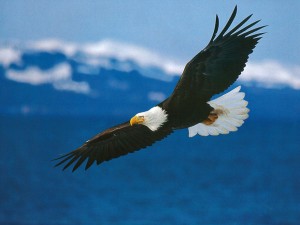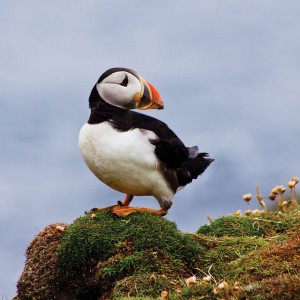By Robert Witkowski
The Moose Chronicles
“I had no idea they’re so big!” says Debbie Clausen. Call it serendipity, call it drive-by wildlife, but something magic is happening in front of her eyes as a moose cow raises her head to a full seven-feet high. As a calf floats over to his mother, Clausen, 52, jumps in her seat, and reaches for her camera. “My kids aren’t going to believe this!”
“When I heard we were going to Moose Alley, I never thought we’d see them like this!” It’s long been a secret among Maine wildlife officials that the stretch of Route 16 between Rangeley and Stratton is as hot to trot for moose as a paranormal hotspot is for ghosts.
Less than a mile past Rangeley Lakes Logging Museum, where an expansive field opens to the left side of the road, this area is a perfect one-two punch for visitors. “Get out of town!” Clausen, a tennis instructor from Madison, Wisconsin, exclaims as more silhouettes of North America’s tallest land mammal step through the twilight into view. “I’m counting 13 cows and calves, and a full-rack bull.”
Also extremely likely at this site: scourges of mosquitoes, rafters of turkeys, and a skulk of foxes.
“You can see moose around sunset almost any night in Moose Alley,” Rangeley Chamber of Commerce’s Gail Spaulding says. “They come out of the woods when it cools down, especially summer nights through August. Then there’s the run from Route 4 to Farmington, Bald Mountain, driving up at Height of the Land—you never know when they might pop out.”
But what if you insist on an absolutely solid-gold guarantee to see a moose and have just two hours until you catch your plane? Though moose occasionally delight crowds at the Castle visitor center in Deering Oaks Park, “the sure fire answer is Gray’s Maine Wildlife Park. You know you’re going to see one there,” says one of the travel associates.
Drive to Gray’s town center and head out Route 26 to Shaker Village near Poland Spring for some unforgettable contact with many of Maine’s wild creatures, some of them rescues under the protection of the Department of inland Fisheries and Wildlife. mainewildlifepark.com
 The Eagle Has Landed
The Eagle Has Landed
The fastest way to see a bald eagle is on the back of a dollar bill. Second fastest? A sweeping glide over Swan Island Wildlife Management Area on the Kennebec River in Richmond.
Since their population is booming in Maine, you’re likely to see one if you spend the day at any of Maine’s lakes or major rivers.
It almost too easy to “send people to Eagle Lake,” says Acadia National Park ranger True Muzzy. “Especially Connors Nubble. Eagles dive into the water, grabbing fish.” You see these incredible splashes. “They like the high pines and stay near water, so you often see them by Thunder Hole.
Eyes In The Headlights
“White-tailed deer and coyotes” are part of Acadia’s mysteries, too, Muzzy says. “They stay out of the heat,” but in the gray hours of evening frequently make an appearance, emerging to feed. “You’ll see them crossing Park Loop Road in groups between 5:30 and 7:30 p.m. Their eyes reflect headlights, so you’ll see them well in the dark…and should be able to stop in time,” he says, conscientiously adding, “if you’re following the 35-mph speed limit.”
Bear Necessities
York’s Wild Kingdom on Route 1 allows close viewings of Maine’s black bears. But if you want an up-close and personal encounter with one of our 25,000 black bears on their turf—the most of any eastern state—it’s possible, just an incredibly stupid idea.
These 600 pounders may seem harmless but should be avoided if encountered “hiking Traveler Mountain or Roaring Brook Road,” Baxter State Park’s naturalist Jean Hoekwater says. “Black bears are generally anywhere there are berries and beech nuts. They’re shy of people but have been known to go after food in a backpack or car. The real danger is coming between a mother and her cub—they’ve been known to make ‘mistakes.’”
They also roam the northern counties for summer love. In Aroostook County, look for
them munching in Caswell’s roadside oat fields along Route 1A.
Shell Shock
Mention the 12-pound lobster at Maine State Aquarium in West Boothbay and watch the bibs come out. But the sure-fire way to see Homarus americanus is only a feast for the eyes. “Children, especially, are always intrigued to see the various color combinations of our lobsters and some with abnormalities, like our four-clawed Dozer,” Aimee Hayden-Roderiques says.
Of course, the Old Port’s Harbor Fish Market, Portland Lobster Company, and Cape Elizabeth’s Lobster Shack at Two Lights are more than happy to introduce people to their evening entrée.
The crustaceans’ wild side is year-round, but three-dimensionally it’s best seen aboard Lucky Catch as it steams from Portland’s Long Wharf through Columbus Day. The two-hour harbor tour of lobster traps informs novices how and where the bottom dwellers live. Passengers can even pull a trap to the surface for some face (and antennae) time.
 Keep on Puffin
Keep on Puffin
“In the 1980s, you’d only see two or three puffins—now there’s hundreds,” John Taylor of Cap’n Fish’s says. He runs cruises out of Boothbay Harbor’s Pier 7 at 42 Commercial Street. Sporting a brilliant red, yellow, and orange beak during the summer mating months, these pint-sized arctic seabirds are only found on the northern Atlantic coast, largely congregating on desolate 1.5-acre Eastern Egg Rock in Muscongus Bay.
The National Audubon Society’s effort to repopulate the species started with Project Puffin in 1986. They’ve coordinated with Cap’n Fish’s from the beginning. Today, a biologist narrates the seabirds’ saga to landlubbers aboard the 100-foot Pink Lady II and Island Lady through August 25. Still considered a threatened species, this southernmost colony “is very successful,” bouncing back with 90 nesting pairs. “We’ve seen them 100 percent of the time the last two years,” Taylor says. Guaranteed.
“The best views of puffins are when they’re in the water. They get real close to the boat—less than 30 feet—and they’re real friendly.”
Whales of (July &) August
If you will it, they will come to you. This particularly happens on Seal Island, the shoals of Jeffrey’s Ledge, and Matinicus Rock. Minke, finback, humpback, and right whales all migrate through the Gulf of Maine until turning to warmer waters in October.
As for promising you’ll see a whale, Cap’n Fish’s ups the ante again with their whale watch 100 percent guarantee: If you don’t see a whale, you get a ticket for another trip until you do. Bring suntan lotion and Dramamine.
“I’ve seen whales every time I go out,” passenger Craig Barnes of Woolwich says. “But this one time they gave everyone a pass for another trip because they said they didn’t think we saw enough whales. Who does that?”
Sailing out of Lubec, Downeast Charter Boat Tours’s Captain Ralph Carol makes the most of his boasts. “Every trip we made two years ago was 100 percent.” Last year the figure was a respectable 75 percent. His 25-foot Lorna Doone “lobster yacht” and 35-foot Red Ryder leave for two-hour and half-day voyages to find the beautiful behemoths 10 miles past Head Harbor Light into Cobscook, Fundy, and Passamaquoddy bays. How does he compete with Cap’n Fish’s? With pure theater and a ham named Gonzo.
“You might see a humpback jump out of the water three or four times, but minkes don’t usually breach like that,” Carol says. “But this one minke we call Gonzo breached 100 times in a row.” Not counting curtain calls.





0 Comments